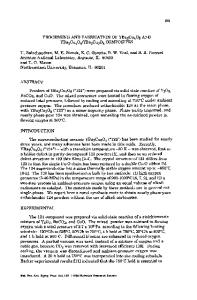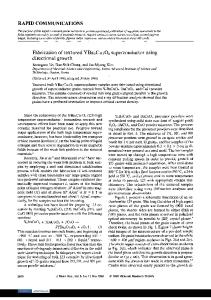Fabrication of H 2 S gas sensors using Zn x Cu 1-x Fe 2 O 4 nanoparticles
- PDF / 2,123,378 Bytes
- 9 Pages / 595.276 x 790.866 pts Page_size
- 81 Downloads / 352 Views
Fabrication of H2S gas sensors using Z nxCu1‑xFe2O4 nanoparticles Mohammad Abu Haija1 · Mariem Chamakh2 · Israa Othman1 · Fawzi Banat3 · Ahmad I. Ayesh2,4 Received: 1 February 2020 / Accepted: 21 May 2020 © The Author(s) 2020
Abstract Spinel ferrite nanoparticles can be easily retrieved and utilized for multiple cycles due to their magnetic properties. In this work, nanoparticles of a ZnxCu1-xFe2O4 composition were synthesized by employing a sol–gel auto-combustion technique. The morphology, composition, and crystal structure were examined using scanning electron microscopy, infrared spectroscopy, and X-ray diffraction. The produced nanoparticles are in the range of 30–70 nm and manifest spinel cubic structure. The nanoparticles were tested for their sensitivity to H2 and H2S gases, and the Cu-based spinel ferrite nanoparticles were found 2S gas was attributed to the production of metallic the most sensitive and selective to H 2S gas. Their enhanced response to H CuFeS2 that manifest higher electrical conductivity as compared with CuFe2O4. The fabricated sensors are functional at low temperatures, and consequently, they need low operational power. They are also simple to fabricate with appropriate cost. Keywords Spinel ferrite · CuFe2O4 · ZnFe2O4 · H2S · Gas sensor · Nanoparticles
1 Introduction Hydrogen sulfide (H2S) gas pollution is considered a crucially poisonous to humans, especially at locations with high production yield such as petroleum extraction, refining, and transportation facilities [1]. It is distinguished with its odor that smells like a rotten egg that is well known at mineral water of thermal springs [2]. The development of efficient sensors is vital for environment monitoring and control in fields that involve H2S emission. Recently, there have been major achievements in the field of gas sensing by different systems including nanomaterials, nanoclusters, and graphene-based materials [3–5]. Nanoparticles consist of groups of atoms with nanometer size, and their chemical and physical properties are unlike their bulk counterparts [6]. Their nanometer size leads to * Ahmad I. Ayesh [email protected] 1
Department of Chemistry, Khalifa University, Abu Dhabi, United Arab Emirates
2
Department of Mathematics, Statistics and Physics, Qatar University, P. O. Box 2713, Doha, Qatar
3
Department of Chemical Engineering, Khalifa University, Abu Dhabi, United Arab Emirates
4
Center for Sustainable Development, Qatar University, P. O. Box 2713, Doha, Qatar
a large percentage of surface atoms that represent active chemical reactive sites [6, 7]. Exposure of nanoparticles to a reactive gas causes its adsorption on the surface sites, thus, change the density of free electrons. As a result, the electrical current signal through a network of nanoparticles is modified [8, 9]. Such a modification in the current signal can be utilized to measure the amount of reactive gas. Conductometric gas sensors are devices that contain networks of nanoparticles that are sensitive and selective to cer
Data Loading...











